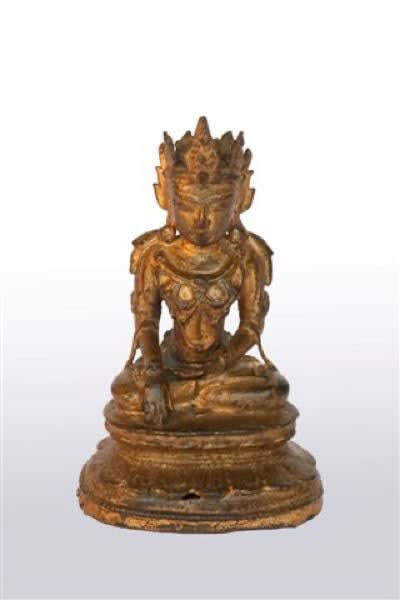Bronze Statue of Seated Buddha, 16th Century CE
Bronze
height 20 cm
height 7 7/8 in
height 7 7/8 in
AB.027 (6904)
A Bodhisattva is an individual who is on the path to enlightenment, but has not yet reached it. According to some definitions, Bodhisattvas are qualified to enter nirvana, but have...
A Bodhisattva is an individual who is on the path to enlightenment, but has not yet reached it. According to some definitions, Bodhisattvas are qualified to enter nirvana, but have chosen not to, because of their desire to remain on earth and help others on their own journeys to overcome sufferings and attain enlightenment. In Early Buddhism, the term was used to refer to the Buddha in the period of his life before he reached nirvana. Different Buddhist schools now hold varying definitions of the term; within Theravada Buddhism, Bodhisattvas are rare individuals who have both made a resolution to become a Buddha and had confirmation from a living Buddha that this will happen. However, within Mahayana Buddhism, a Bodhisattva is anyone who has the quality of bodhicitta: a mind (‘citta’) directed towards enlightenment (‘bodhi’), or a wish to attain Buddhahood for the good of all sentient beings. According to this understanding, everyone has the opportunity to become a Bodhisattva.
Bodhisattvas are often represented with elaborate clothing and adornment. This contrasts with depictions of the Buddha, which emphasise his renouncement of earthly riches by portraying him clothed in plain robes. This figure is wearing earrings, a decorative many-pointed headdress, and chains across his chest. He is sitting in a full lotus position upon a platform. The figure’s hands are held in the Bhumisparsha mudra, with his right hand reaching downwards across his right knee towards the ground, and his left resting face-up over his legs. The Bhumisparsha or ‘earth witness’ mudra (gesture or body position with a symbolic meaning and connection to an event in the life of the Buddha) represents the connection which the Buddha made with the earth when he was close to achieving Nirvana. The demon Mara was trying to frighten him and interrupt his meditation, and as part of this challenged him to produce a witness to agree that he had the right to achieve enlightenment. As the Buddha touched the ground, the earth itself appeared as his witness, allowing him to defeat Mara and prove himself worthy of reaching Nirvana. The expression on the figure’s face is peaceful, with closed eyes, conveying the sense of inner serenity that can be achieved with spiritual focus and meditation.
Bodhisattvas are often represented with elaborate clothing and adornment. This contrasts with depictions of the Buddha, which emphasise his renouncement of earthly riches by portraying him clothed in plain robes. This figure is wearing earrings, a decorative many-pointed headdress, and chains across his chest. He is sitting in a full lotus position upon a platform. The figure’s hands are held in the Bhumisparsha mudra, with his right hand reaching downwards across his right knee towards the ground, and his left resting face-up over his legs. The Bhumisparsha or ‘earth witness’ mudra (gesture or body position with a symbolic meaning and connection to an event in the life of the Buddha) represents the connection which the Buddha made with the earth when he was close to achieving Nirvana. The demon Mara was trying to frighten him and interrupt his meditation, and as part of this challenged him to produce a witness to agree that he had the right to achieve enlightenment. As the Buddha touched the ground, the earth itself appeared as his witness, allowing him to defeat Mara and prove himself worthy of reaching Nirvana. The expression on the figure’s face is peaceful, with closed eyes, conveying the sense of inner serenity that can be achieved with spiritual focus and meditation.
